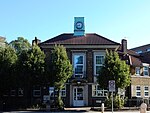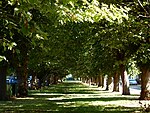West Drayton railway station
DfT Category E stationsFormer Great Western Railway stationsGreat Western Main LineLondon stations without latest usage statistics 1415London stations without latest usage statistics 1516 ... and 6 more
London stations without latest usage statistics 1617Rail transport stations in London fare zone 6Railway stations in Great Britain opened in 1838Railway stations in the London Borough of HillingdonRailway stations served by the Elizabeth lineUse British English from August 2012

West Drayton railway station serves West Drayton and Yiewsley, western suburbs of London. It is served by local trains operated by the Elizabeth line. It is 13 miles 71 chains (22.3 km) down the line from London Paddington and is situated between Hayes & Harlington to the east and Iver to the west. The station is managed by Transport for London (TfL).
Excerpt from the Wikipedia article West Drayton railway station (License: CC BY-SA 3.0, Authors, Images).West Drayton railway station
Warwick Road, London Yiewsley (London Borough of Hillingdon)
Geographical coordinates (GPS) Address Nearby Places Show on map
Geographical coordinates (GPS)
| Latitude | Longitude |
|---|---|
| N 51.509941666667 ° | E -0.47226388888889 ° |
Address
West Drayton
Warwick Road
UB7 9BS London, Yiewsley (London Borough of Hillingdon)
England, United Kingdom
Open on Google Maps






